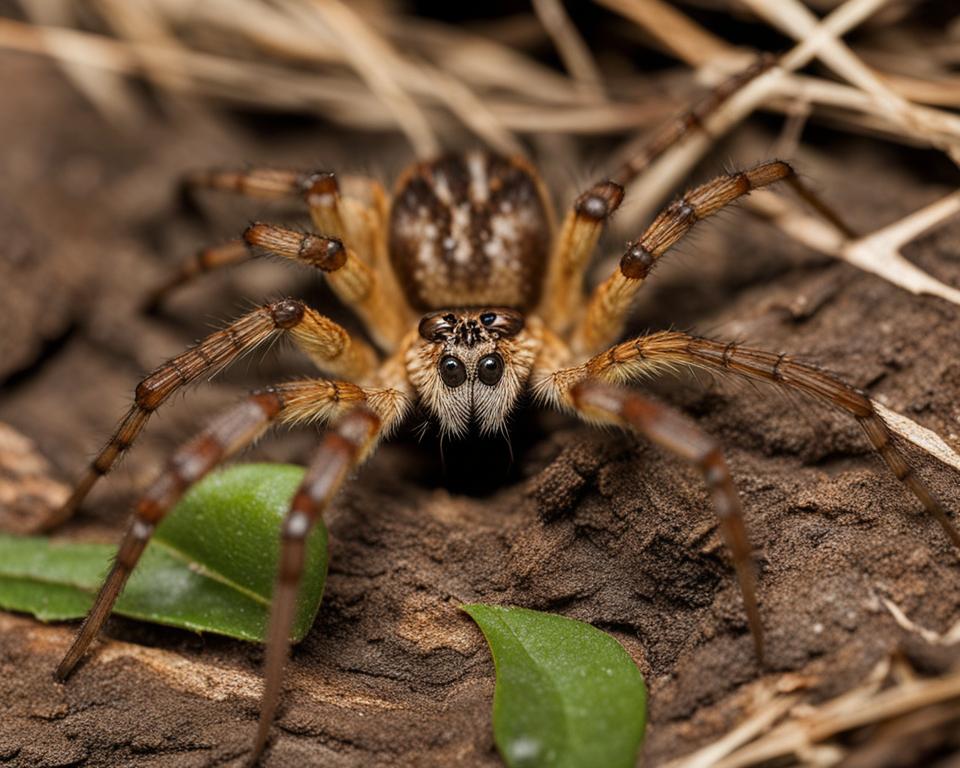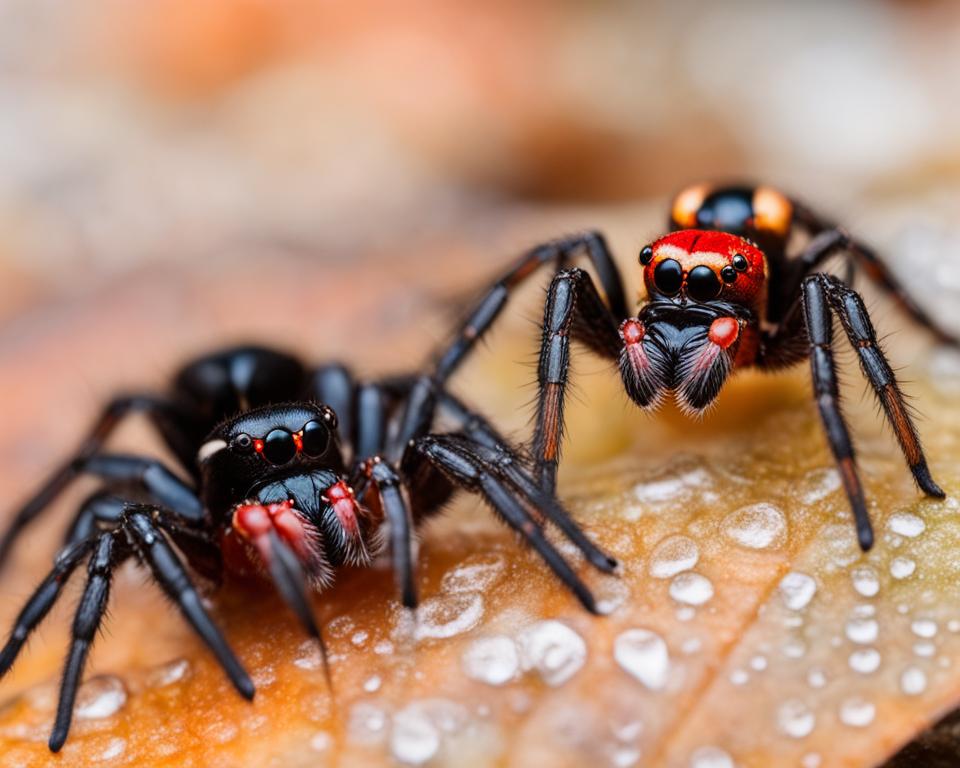If you live in the United States, chances are you’ve heard of hobo spiders and black widows – two venomous spiders known for their harmful bites. While both may look alike at first glance, they have distinct differences that are important to know for identification and safety purposes.
In this section, we will explore the key differences between hobo spiders and black widows, including their characteristics, habitats, and venom potency.
Key Takeaways:
- Understanding the differences between hobo spiders and black widows is crucial for proper identification.
- Hobo spiders are brown with distinct chevron-shaped markings, while black widows have a shiny black body with a red hourglass shape on their abdomen.
- Black widows are known for their highly potent venom, while hobo spiders have venom that is generally less harmful.
- Hobo spiders prefer dark, moist habitats, while black widows tend to live in dry, secluded areas.
- Knowing the risks associated with their bites and how to prevent encounters can help keep you and your surroundings safe from these venomous spiders.
Identification and Characteristics
Knowing how to identify hobo spiders and black widows is crucial for understanding their potential harm and taking precautions. The hobo spider’s appearance is often mistaken for that of the brown recluse spider. However, hobo spiders have a distinct chevron shape on their abdomens, and the males have two large palps at the front of their heads. On the other hand, black widows are known for their distinctive shiny black bodies with red hourglass markings on their abdomens, with some species having a red spot on their backs.
| Feature | Hobo Spider | Black Widow Spider |
|---|---|---|
| Color | Brown with chevron shapes on the abdomen | Shiny black with red hourglass markings on the abdomen |
| Size | Adults range between 1/3 to 2/3 inches (8 to 16 mm) | Adult females can grow up to 1.5 inches (38 mm), while males are smaller |
| Behavior | Active and fast-moving, especially in the fall when looking for mates and breeding | Usually shy and reclusive, bites occur when disturbed or threatened |
| Geographical Distribution | Most commonly found in the Pacific Northwest region and Western United States | Can be found throughout the United States, especially in the southern and western regions |
Hobo spiders are typically found in grassy and dry environments, such as basements, attics, and crawlspaces. On the other hand, black widows prefer warmer climates and can be found in dry, dark, and sheltered areas such as barns, woodpiles, and garages. Hobo spiders are often found outside or in low traffic areas of homes, while black widows tend to hide in undisturbed areas.
When it comes to bites, hobo spider venom contains toxins that can have necrotic effects on the skin, similar to brown recluse spiders. Black widow bites, however, contain a neurotoxin that can cause intense pain and muscle spasms. If you suspect a hobo spider or black widow bite, seek medical attention immediately.
Habitat and Behavior
Understanding where hobo spiders and black widows prefer to live and their typical behaviors can help you avoid encounters or know what to expect.
Hobo Spider Habitat
The hobo spider is typically found in dry, warm environments such as rocky landscapes and fields. They also tend to take shelter in man-made structures like sheds, garages, and basements.
Did you know? The hobo spider is an invasive species in the Pacific Northwest region of the United States, originating from Europe.
When inside homes or buildings, hobo spiders often hide in cracks or crevices, making them difficult to spot. They are most active during the night and prefer to make their webs close to the ground.

Black Widow Behavior
Black widows can be found throughout the United States, living in dark, sheltered environments like woodpiles, basements, and cluttered garages. They are known for their shiny black bodies and distinctive red hourglass marking on their abdomen.
Did you know? Male black widow spiders rarely bite humans and are much smaller and less venomous than females.
Black widows are shy spiders and will likely only bite humans when they feel threatened or cornered. Their webs are irregular and typically found in areas with little traffic, like undisturbed corners or crevices.
Venomous Bites
Both hobo spiders and black widows are known to deliver venomous bites that can be dangerous to humans.
Hobo Spider Bites
If bitten by a hobo spider, you may experience symptoms such as pain, redness, and itching at the bite site. The bite may also cause nausea, fatigue, and muscle pain.
In rare cases, hobo spider bites can lead to more severe symptoms, including necrotic lesions (death of surrounding tissue) and systemic illness.
If you are bitten by a hobo spider:
- Wash the bite site with soap and water
- Elevate the affected limb to reduce swelling
- Use a cold compress to reduce pain and swelling
- Seek medical attention if symptoms worsen or persist
Black Widow Spider Bites
A black widow spider bite may cause symptoms such as pain, swelling, and redness at the bite site. The bite may also cause muscle cramps, nausea, and headaches.
In rare cases, black widow spider bites can lead to more severe symptoms, including muscle rigidity and spasms, sweating, and even seizures or death.
If you are bitten by a black widow spider:
- Wash the bite site with soap and water
- Apply a cold compress to reduce pain and swelling
- Seek medical attention immediately, especially if you experience severe symptoms or have been bitten by a female black widow spider
It is important to note that while hobo spider bites can be dangerous, they are often misdiagnosed and mistaken for bites from other spiders or insects. It is also worth noting that not all black widow spider bites result in severe symptoms and medical intervention.

A Closer Look: Hobo Spiders vs Black Widows
Now that we have explored the characteristics and behaviors of hobo spiders and black widows, it’s time to take a closer look and compare the two species side by side. By comparing their physical appearance, venom potency, behavior, and other distinguishing features, you can gain a more comprehensive understanding of these two venomous spiders.
| Hobo Spider | Black Widow | |
|---|---|---|
| Physical Appearance | The hobo spider is brown with a violin-shaped marking on its cephalothorax. (1) | The black widow is shiny black with a red or orange hourglass marking on its abdomen. (2) |
| Venom Potency | The venom of the hobo spider is less potent than that of the black widow, but still poses a risk to humans. (3) | The venom of the black widow is highly potent and can cause serious symptoms and even death. (4) |
| Behavior | The hobo spider is a more aggressive spider and tends to bite when provoked or threatened. (5) | The black widow is a shy spider that typically only bites in defense. (6) |
| Other Distinguishing Features | The hobo spider is known for its funnel-shaped webs and prefers to live in dark, damp locations. (7) | The black widow spins tangled webs in undisturbed areas and usually lives alone. (8) |
When comparing hobo spiders to black widows, it’s clear that they possess distinct differences, from physical appearance to behavior and venom potency. While both species may be venomous, it’s important to always exercise caution and avoid contact with these spiders in order to minimize the potential risk of a bite.
Conclusion
Now that you have read about the key differences between hobo spiders and black widows, as well as their identification, characteristics, habitats, behaviors, and venomous bites, you are better equipped to identify and avoid encounters with these venomous spiders.
Remember that prevention is the best method for avoiding spider bites. Keep your surroundings clean and clutter-free, wear protective clothing when working outside, and be cautious when handling or disturbing spider habitats.
If you suspect that you have been bitten by a hobo spider or black widow, seek medical attention immediately. Do not attempt to treat the wound yourself; instead, follow the advice of medical professionals.
By staying informed and taking precautions, you can minimize the risk of harm from these venomous spiders. Stay safe!
FAQ
What are the key differences between hobo spiders and black widows?
Hobo spiders and black widows have several distinct differences. While both are venomous spiders, hobo spiders are usually brown with chevron-shaped markings on their abdomen, while black widows are shiny black with a red or orange hourglass marking on their underside. Additionally, hobo spiders build funnel-shaped webs, while black widows construct messy, irregular webs.
How can I identify hobo spiders and black widows?
To identify hobo spiders, look for their distinctive funnel-shaped webs and chevron markings on their abdomen. They also have a V-shaped pattern connecting their eyes. Black widows, on the other hand, have a shiny black body with a red or orange hourglass marking on their belly. Their webs are irregular and messy.
Where do hobo spiders and black widows usually live?
Hobo spiders are frequently found in the Pacific Northwest and parts of Canada, particularly in dark, damp areas like basements, garages, and crawl spaces. Black widows prefer warmer regions, such as the Southern United States. They are often found in outdoor structures, sheds, and woodpiles.
Are hobo spider bites dangerous?
While hobo spider bites can be uncomfortable and cause symptoms such as redness, swelling, and itching, they are not typically considered dangerous. However, if you suspect you have been bitten by a hobo spider, it is advisable to seek medical attention, as some individuals may experience stronger reactions.
How dangerous are black widow bites?
Black widow bites can be dangerous and potentially life-threatening, especially for young children, the elderly, or individuals with compromised immune systems. Symptoms may include severe pain, muscle cramps, sweating, and nausea. If you are bitten by a black widow, seek immediate medical attention.
What should I do if I’m bitten by a hobo spider or black widow?
If you are bitten by a hobo spider or black widow, it is important to clean the wound with soap and water and apply an antiseptic. Seek medical attention promptly, as doctors can provide appropriate treatment and further assess the severity of the bite.
